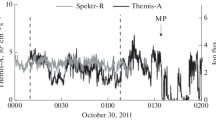Abstract
Horizontal motion has been studied of the matter along the active region at different heights of the photosphere (115–580 km) in the initial phase of the two-ribbon solar flare on September 4, 1990, near the solar limb, accompanied by the ejection. Photospheric velocities varied in the range −3.5 ... 2.5 km/s. The direction of motion in the photosphere and the chromosphere was mainly toward the observer. Kinematic elements have been discovered in the structure of the horizontal velocity field. Their size reduced as they approached the maximum of the flare from 7–12 to 4–5 Mm, and the velocity amplitude decreased. Throughout the whole investigated active region, vortex motions were observed in the photosphere and chromosphere. Temporal changes in the horizontal velocity field in node areas and in their vicinity were oscillatory in nature and occurred almost simultaneously along the entire height of the photosphere.
Similar content being viewed by others
References
K. V. Alikaeva and N. N. Kondrashova, “Disturbance of the Photosphere during Solar Two-Ribbon Flare,” Kinem. Fiz. Nebes. Tel 22(3), 163–172 (2006).
N. N. Kondrashova and M. N. Pasechnik, “Photospheric Layers of a Flare and a Plage. III. The Velocity Field,” Kinem. Fiz. Nebes. Tel 15(4), 310–317 (1999).
N. N. Kondrashova and M. N. Pasechnik, “Radial Velocities of the Photospheric Matter in a Solar Flare with Matter Ejection,” Kinem. Phys. Celest. Bodies 26, 26 (2010).
M. N. Pasechnik, “Movement of Chromospheric Substance in Active Region during the Solar Flare with Matter Ejection,” Visn. Kiiv Nauch. Univ. Tarasa Shevchenka, Astron., Nos. 39–40, 13–16 (2003).
E. R. Priest, Solar Magnetohydrodynamics (Reidel, Dordrecht, Holland, 1982).
T. I. Redyuk, “Movement of Matter on Photosphere Level in Flare-Active Regions,” Vestn. Kiev. Univ. Tarasa Shevchenko, Astron., No. 32, 28–35 (1990).
Soln. Dannye, Byull., No. 9 (1990).
S. N. Chornogor and K. V. Alikaeva, “Radial Velocity Field in Hα-Loops during Bright Solar Flare,” Kinem. Fiz. Nebes. Tel 19(5), 417–430 (2003).
R. C. Canfield, K. P. Reardon, K. D. Leka, et al., “Hα-Surges and X-Ray Jets in AR 7260,” Astrophys. J. 464(2), 1016–1029 (1996).
V. S. Gorbachev and B. V. Somov, “Photospheric Vortex Flows as a Cause for Tow-Ribbon Flares. A Topological Model,” Solar Phys. 117(1), 77–88 (1988).
K. L. Harvey and J. W. Harvey, “A Study of the Magnetic and Velocity Fields in an Active Region,” Solar Phys. J. 47(1), 233–246 (1976).
G. Roumeliotis and R. L. Moore, “A Linear Solution for Magnetic Reconnection Driven by Converging or Diverging Footpoint Motions,” Astrophys. J. 416(1), 386–391 (1993).
Solar Geophys. Data 559, II (1991).
B. V. Somov, T. Kosugi, H. S. Hudson, et al., “Magnetic Reconnection Scenario of the Bastille Day 2000 Flare,” Astrophys. J. 579(2), 863–873 (2002).
Author information
Authors and Affiliations
Additional information
Original Russian Text © N.N. Kondrashova, M.N. Pasechnik, 2011, published in Kinematika i Fizika Nebesnykh Tel, 2011, Vol. 27, No. 5, pp. 12–25.
About this article
Cite this article
Kondrashova, N.N., Pasechnik, M.N. Radial velocity field in the lower atmosphere of the solar active region during a flare with an ejection: The initial phase of the flare. Kinemat. Phys. Celest. Bodies 27, 224–232 (2011). https://doi.org/10.3103/S0884591311050059
Received:
Published:
Issue Date:
DOI: https://doi.org/10.3103/S0884591311050059




